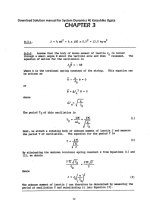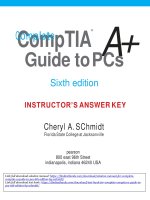Link download solution manual for american history connecting with the past 15th edition by alan brinkley
Bạn đang xem bản rút gọn của tài liệu. Xem và tải ngay bản đầy đủ của tài liệu tại đây (200.68 KB, 12 trang )
Solution manual for American History Connecting with
the Past 15th Edition by Alan Brinkley
DEBATING THE PAST
The essay on pages 58 and 59 of the textbook discusses how historians have
interpreted “Native Americans and the ‘Middle Ground.’” Teachers may have
their students read the essay and respond to the questions on page 59. Student
responses might include the following.
1. Identify three camps of historical views regarding the relationship
between Native Americans and the European settlers. Name a historian
representative of each view, and provide one piece of historical evidence
that supports the view.
One “camp” would be 19th century historians like Francis Parkman who argued
that the American Indians were uncivilized, sometimes brutal, sometimes
peaceful, who were an obstacle to European settlement. An example would be
wars such as the Pequot War or King Philip’s War in which the English settlers
defeated the Indians and drove many out of the area. A second perspective
suggests that American Indians and Europeans combined their characteristics to
create aspects of a blended American culture. James Merrill is an example of this
view. The treaties made between American Indians and Europeans and their trade
with each other would support this argument.
A third view represented by Joyce Chaplin suggested that the views Europeans
had of the American Indians changed over time. At first, the Indians were seen
as “noble,” but, after many Indians died from European diseases or fought
against the Europeans, their image changed to one of inferior to the European
whites. An example would be the ravages of small pox on the Indian population
or King Philip’s War and the loss suffered by an”inferior” enemy, as the English
came to believe.
2. Offer a circumstance or factor surrounding one or more of these historians,
which might have influenced the historian’s perspective.
Francis Parkman in the late 19th century wrote at a time when Indian wars were still
going on. The Indians were still seen as an obstacle to settlement in the Great
Plains by Americans or as “uncivilized” people who needed to be educated and
assimilated [Dawes Act].
Later historians were influenced by more progressive ideas of Indians as people
in light of the Progressive movement of the early 20th century or the Civil Rights
movement of the middle to late 20th century.
3. If you were writing a history of European settlement in North America,
name an event which you would consider significant, such that it is a
turning point in the relationships between Native Americans and
European settlers. Explain.
This question could lead to good class discussions. Students could come up with
a variety of answers.
Use your knowledge of U.S.
history to answer questions 3–5.
1
Answer a, b, and c.
Briefly explain ONE example of conflict
between Native peoples and colonists in the
17th century.
Briefly explain a SECOND example of
conflict between Native peoples and colonists in
the 17th century.
Briefly explain ONE example of intragroup conflict among colonists in the
17th century.
SCORING NOTES
A/B) Explanations of one example of conflict between Natives and
colonists may include the following.
The clashes in the early 1600s between the Powhatan Indians and
the settlers of Jamestown over territory and various affronts led to
years of turmoil and near collapse of the colony before the final
suppression of the Natives.
The Pequot War in Connecticut in the 1630s was sparked by conflict
over land and trade competition. The colonists, aided by rival tribes,
nearly wiped out the Pequot tribe amid brutal acts of war.
King Philip’s War was the most dangerous instance of resistance to
the New England colonists. King Philip (Metacomet) led a well
organized coalition of tribes in opposition to further encroachments
by English settlers and customs. The conflict took a significant toll
upon the settlers and their economy but Metacomet and his
Wampanoag Indians were overcome by the English and their native
allies.
C)
Explanations of one example of intra-group conflict
among colonists may include the following.
The colony of Maryland was torn between factions supporting the
Catholic minority, supported by the Claverts the colonial
proprietors, and the Protestant majority. The Protestant seeking to
ensure Protestant say in government and the Catholic minority
seeking to guarantee their religious freedoms and political rights.
John Coode’s rebellion in 1689 successfully removed the possibility
of Catholic equality in Maryland and established Protestant
dominance there.
Bacon’s Rebellion was the most significant internal conflict of the
early colonies. It pitted the people of the “back-country” of Virginia
against the ruling elite of the colony with him they differed on
policies of Indian relations and political representation. The turmoil
showed the need for continued territorial expansion and the
potential for social turmoil entailed in continued immigrating by
landless indentured servants.
Once the English seized control of New Amsterdam, there would
be persistent tension and political conflict between the English
and traditional Dutch land owners of the region.
Answer a, b, and c.
Briefly explain ONE example of continuing
contact
between the Native Americans and
European colonists in the 17th century.
2
Briefly explain ONE example of how
continuing contact between Native
Americans and European colonists in the
17th century brought about a cultural or
demographic change in one group or the
other.
Briefly explain ONE example of differences in
how the various European nation colonizers
reacted to intensified conflicts with Native
Americans.
SCORING NOTES
A)
Explanations of one example of continuing contact between the
Native Americans and European colonists may include the following.
Native Americans continued to serve as an essential source of aid
and knowledge for the settlers as illustrated by the interactions of
the Puritans with Squanto and others, who provided aid on how to
farm the local produce and hunt the available game.
Missionary activity persisted as an important point of contact between
the natives and all of the various European colonies. The work of
missionaries was essential to the spread of European culture and
mores to the natives.
The most important and pervasive point of contact continued to be
through trade. In many ways, the trade with native groups was
essential to the survival and economic advancement of the colonies
in all regions of North America. Natives provided many of the raw
materials (furs etc…) for export by colonists as well as a market
for manufactured goods brought in to the colonies from Europe.
B)
Explanations of one example of how continuing contact
between the Native Americans and European colonists brought about
cultural or demographic change may include the following.
Continuing contact with colonists brought displacement and death to
the majority of natives in the regions of colonization. The continued
spread of disease (such as small pox) and persistent conflict (as
illustrated by the Pequot War and King Philip’s War) depleted the
resources and population of the natives to the point of being unable
to resist the colonists further.
Continuing contact with natives led to conflict, some of which
threatened to exterminate the colonial settlements (such as seen
in the early years of Jamestown and during King
Philip’s War), but more importantly it provided the colonists with
further opportunities for trade and exploitation.
C)
Explanations of differences in how the various
European nation colonizers reacted to intensified conflicts
with Native Americans may include the following.
Unlike early policies focused upon exterminating opposition
native populations, the Spanish shifted toward policies of
conciliation as illustrated by their dealing with the Pueblo
uprising. Some increased liberties and say for natives allowed the
Spanish to maintain control with their relative small population of
Spanish colonists.
English settlers tended toward continued warfare with the natives
as they continued to push the boundaries of their settlements while
displacing Indians from their traditional lands, as seen in both
Virginia and New England.
3
Answer a, b, and c.
Briefly explain ONE example of diverse
patterns of
colonization in America among the European
nations in the 17th century.
Briefly explain a SECOND example of diverse
patterns of colonization in America among the
European nations in the 17th century.
Briefly explain ONE example of differences
in regional development among the British
colonies.
SCORING NOTES
A/B) Explanations of one example of diverse patterns of colonization
in America may include the following.
The English tended toward the plantation model of
settlement. Seeking to establish distinct, separate societies
within the Americas.
The Spanish maintained smaller colonial populations than the
English and tended to subjugate rather than expel the native
populations. Additionally, the Spanish later tended to attempt
to cultivate trade relations with the native tribes.
The French and Dutch each groomed smaller, less threatening colonial
populations and as a result cultivated successful trade relations with
native tribes that aided them economically without the same degree of
involvement in internal conflicts.
C)
Explanations of one example of differences in regional
development among British colonies may include the following.
The English Caribbean and Southern colonies became dependent
upon forced, slave labor to produce labor-intensive cash crops for
market with only minor white populations to oversee the production,
particularly in the Caribbean.
The northern English colonies in New England and the midAtlantic tended to support more extensive self-sufficient
settlements.
The religious motives behind the founding of the several of the New
England colonies, as well as Pennsylvania and Maryland produced
distinctive societies and personalities for each of those regions.
Develop a thoughtful and thorough historical argument that
answers the question below. Begin your essay with a thesis statement and
support it with relevant historical evidence.
Some historians have argued that economic concerns were largely responsible
for the differences in regional social and political development of the British
colonies in the Americas. Support, modify, or refute this interpretation,
providing specific evidence to justify your answer.
4
SCORING NOTES
Thesis: Possible thesis statements supporting, modifying, or refuting the
interpretation may include the following.
The differing economic potentials of various regions dictated the arrival of
differing populations to each region and thus dictated the manner of
society that would develop in that region.
Religion played a more important role in the distinct development of
the various English colonies than simple economics.
A balance of religion and economics determined the social and political
development of the various English colonies.
The development of colonies was far too complex to be narrowed to an
over-riding influence of just economics but must include religion,
ethnicity, climate and a host of other variables.
Support for argument: Possible evidence that could be used for an
argument stressing the role of economics in the development of
English colonies includes the following.
The relatively rapid development of colonies in Virginia and the
Caribbean was spurred by the economic potential of those locations.
The suitability of the Southern and Caribbean colonies producing cash
crops led to the development of first indentured labor and later slave
labor to provide the workforce needed for labor intensive cash crops such
as sugar, rice, and tobacco.
The lack of suitability of New England colonies for cash crops led to an
increased prevalence of smaller subsistence farms and the development of
shipping and eventually manufacture as a means to support the region,
while exporting natural resources (timber, furs etc…) rather than produce.
Support for argument: Possible evidence that could be used for an
argument stressing the role of religion in the development of English
colonies includes the following.
The origins of the first New England settlers as Puritan dissenters
guaranteed that there would be a religious character to the development
of the region.
The founding of Maryland under the auspices of Catholic proprietors led to
definitive turmoil between the Catholics and the Protestant settlers that
were needed to provide ample populace for the success of the colony. The
tensions between these groups would leave a clear impression upon the
politics of the colony.
Religious dissent and disputes became the primary cause for the
development of multiple New England colonies, namely Massachusetts,
Rhode Island, and Connecticut, rather than a single New England
colony. Pennsylvania was created precisely to provide a religious refuge
from persecution, with economic motivations seemingly secondary to the
religious goals.
Application of Historical Thinking Skills
Essays earn points by using the evidence offered in support of their argument
to identify and illustrate continuity and change over time. Examples include,
but are not limited to, the following.
The origins of multiple colonies were religious, but time showed the overriding importance of economics as each colony became more integrated
into the commerce of the Empire and more secular over time.
The distinct characteristics of the various colonies continued
throughout the Revolutionary era, the formation of the Republic, and in
many ways until the present day.
Synthesis
Essays can earn the point for synthesis by crafting a persuasive and
coherent essay. This can be accomplished by providing a conclusion that
extends or modifies the analysis in the essay or by
5
connecting to another historical period or context. Examples could include,
but are not limited to, the following.
Explaining how the differing characteristics of the different colonies’
founding and growth shaped their development can be reflected in
their reactions to the various crises of the later Republic.
Comparison of the roles of economics as opposed to religion in later
periods, such as expansion of corporations, through discussion of
movements such the Social Gospel can illuminate the impetus of
economics in society and the religious reaction to the impact of
economic-driven decisions.
6









